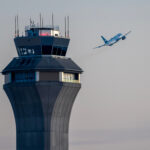An aerospace technology company based in the UK is teaming up with leading global airlines in an effort to dramatically reduce aviation’s non-CO2 climate impact by preventing the formation contrails.
Cambridge-based Satavia uses atmospheric modelling to predict the cold, moist air layers that lead to contrail formation.
With forecasts in hand, the company then works with airlines to optimise their flight plans for contrail prevention, recommending small changes in altitude to avoid these layers.
5% of flights need small modifications
On average, only around 5% of flights need these small modifications to avoid the vast majority of contrail climate impact, so it’s a light-touch solution, said Satavia’s Conor Farrington.
Speaking to FINN, he said: “Post-flight, we verify the flown trajectory and use hindcast weather data to ensure we have the best possible analysis of avoided climate impact. We store this in the blockchain for conversion into future carbon credits, which is key to incentivising adoption across commercial aviation.”
In recent months Satavia has entered partnerships with Etihad Airways and KLM to further explore this potentially game-changing method of reducing aviation’s environmental impact.
“Contrails represent aviation’s biggest climate challenge, generating a climate impact of up to 2.4 billion tonnes of carbon dioxide equivalent each year according to the latest scientific research, compared to around 1 billion tonnes of carbon dioxide arising from direct engine emissions,” said Farrington.
“Fortunately, while engine emissions require years or decades to reduce with new fuels and propulsion systems, contrail prevention is available today with software solutions like Satavia’s DECISIONX:NETZERO platform.
“This means we can make big inroads into aviation’s overall climate footprint on very short timescales. Looking at it from another perspective, there is no route to true net zero flight without contrail prevention.”
Contrail-linked climate change
Altering the altitudes of less than 2% of flights could reduce contrail-linked climate change by 59 per cent, according to one Imperial study.
And Dr Edward Gryspeerdt, research fellow and lecturer at the Grantham Institute, who has studied the impact of contrails, said that the warming effect of the contrails in the atmosphere today “is more than all the CO2 that has been emitted by aircraft since the dawn of flight”.
Farrington said: “Aviation has had a difficult journey towards more sustainable flight, with numerous missed targets and pushback from a number of vested interests who stand to lose out from decarbonisation – so it’s understandable that stakeholders haven’t been particularly keen to engage with a large new climate liability arising from non-CO2 effects like contrails.”
Airline partnerships
Earlier this year, Satavia and Etihad, the national carrier of the United Arab Emirates (UAE), signed a ground-breaking contrail management contract. This built on a previous proof-of-concept engagement to expand the scope for contrail management within day-to-day flight operations.
The partnership also incorporates an agreement to collaborate on the generation of future carbon credits from contrail management activity.
“We’ve worked with Etihad, KLM and KLM Cityhopper, as well as several other operators we have engaged with on the back of support from the European Space Agency, gaining a degree of operational contrail management experience that is probably unparalleled globally,” added Farrington.
“Each airline has a slightly different approach to operations and sustainability, so there is always a lot to learn in terms of flight dispatch and other processes.
“One of the key wider learning points has been around the need for collaboration with multiple stakeholders involved in commercial aviation, particularly air navigation service providers and other air traffic control stakeholders with the capacity to enable navigational manoeuvres required for contrail management.
“With proactive engagement, the likelihood of successful optimisations increases, so this is one of our key priorities.”
Gold Standard
Earlier this month, Gold Standard, the world-leading carbon and sustainable development standard, granted approval for Satavia’s contrail management methodology concept.
The decision paves the way for the future issuance of non-CO2 “Certified Mitigation Outcome Units (CMOUs)”, providing an incentive for aircraft operators to reduce the climate impact associated with aircraft contrails.
“We have multiple exciting developments in the pipeline, spanning operational engagements with major airlines, R&D partnerships with leading global corporates in the world of aerospace engineering, and commercial engagements with multiple players in voluntary carbon markets, alongside ongoing scientific validation work and accreditation with Gold Standard,” Farrington said.
“Gold Standard approval of our methodology concept is a major step forward for efforts to tackle aviation’s non-CO2 effects, creating a pathway towards near-term incentives for operators doing contrail management.
“Airlines and others who declare a non-CO2 climate inventory and use our technology to prevent contrails will be able to claim credits – Certified Mitigation Outcome Units (CMOUs) – for each tonne of climate impact avoided.
“Operators can then trade these units on the voluntary carbon market and/or retire them against net zero targets. And that means that we can generate finance to support climate mitigation activity that wouldn’t otherwise take place in the absence of regulation – offering a rare example of low-hanging fruit in the effort to make flying more sustainable.”
Subscribe to the FINN weekly newsletter

